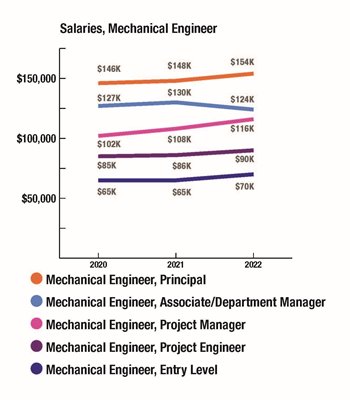From Professional Services to Manufacturing, ME Compensation is Up
From Professional Services to Manufacturing, ME Compensation is Up


How much mechanical engineers earn depends on industry, education, experience, responsibilities, talents, and geography. Add technology and an aging workforce, and MEs earning power is guaranteed.
More than 277,000 mechanical engineers are currently employed in the U.S., according to the most recent National Occupation Employment and Wage Estimates published by the U.S. Bureau of Labor Statistics (BLS).
Recent data from the BLS takes its numbers from the Current Population Survey, a national survey that asks about wages and salaries, and the findings reveal MEs as a group are earning more even as senior MEs retire and are replaced by newly minted engineers.
The median yearly wage estimates for MEs at $96,310 not only stands well above the national average, but the top 10 percentile makes an average annual wage of $151,260. In fact, those MEs at the bottom of the pack (the bottom 10 percentile) make just about the same as the average earner in the U.S—$61,990 annually.
Many would assume that most MEs work in the machinery manufacturing sector. But the nearly 30,000 MEs who are employed in this industry come in a distant second as the industry employing the most MEs. These engineers do represent 3.47 percent of all those employed in the sector and earn an annual mean wage of $89,940, but it is not the industry where most MEs ply their trade.
The architecture, engineering, and related industry employs the most mechanical engineers with a little over 55,000 working for AE firms. According to BLS, these engineers who make up 3.47 percent of that industry’s employees earn an annual mean wage of $102,290.
These numbers look very much in line with those reported by Zweig Group, which found that, when compared to a year prior, every level of MEs saw increases in pay, except associate/department manager.
When looking at the most recent data, “We found that—broadly speaking—engineers, early in their careers, got an increase of base compensation of 9 percent, compared to more established professionals who receive an increase on average of about 4.5 percent,” explained Will Swearingen, principal and director, ownership transition, Zweig Group in Fayetteville, Ark. Moreover, larger firms (over 250 in staff size) offered staff an average increase of 9.3 percent, versus the 6.7 percent given by smaller firms.
The approach is driven in large part to the talent shortage within AE, Swearingen explained. “Couple this with inflation that hit a 40-year-high of 7 percent in 2022,” he added. Swearingen sees the demand for MEs staying stable as such projects as retrofitting commercial spaces and dealing with antiquated mechanical systems come online. “Existing facilities will need to be made more energy efficient and feature sustainable systems,” he said.
According to the BLS, the industry with the highest concentration of MEs is the engine, turbine, and power transmission equipment manufacturing sector. A little more than 4,200 MEs make up 4.78 percent of the that industry’s employment. And these MEs, despite not working for the industry that pays MEs the most, earn an annual mean wage of $103,000.
The honor of being the top industry when it comes to paying MEs is the oil and gas extraction industry. Just under 400 MEs report an annual mean wage of $161,340. Coming in second is the pipeline transportation sector. Only 40 MEs are listed doing this job, but they have an annual mean wage of $147,060.
Become a Member: How to Join ASME
The state that most MEs work in is Michigan with nearly 32,000 MEs working within the state. With an average mean wage of $95,480, these MEs represent 7.5 workers for every 1,000 jobs in Michigan. This makes them the state with the most MEs per thousand of workers in the U.S.
However, the state where MEs earn the most is New Mexico. With an average mean wage of $126,080, these MEs represent 2.06 workers for every 1,000 jobs in N.M. The city of Detroit is where most MEs earn their income. More than 20,000 MEs work for companies in that city and their annual mean wage is $98,570. However, the city where MEs earn the most is San Jose, Sunnyvale, Santa Clara, in California. More than 3,700 MEs work for companies located in this city and report an annual mean wage of $140,750.
Where do engineers stand when it comes to a wage gap? Zweig found overall that men in AE do earn 17 percent more, overall, when compared to women. “But with the proliferation of programs aimed to make a culture more diverse, equitable, and inclusive, we see women’s pay increasing at a greater clip than other groups,” Swearingen explained. "So we see the gap with more experience female engineers more than those just entering the workforce."
Finally, to earn more engineers must train for the future. “We at Zweig provide training and other resources for those who want to move into leadership roles, sell services, or run large projects,” he said.
“The future is bright for engineering firms, mechanical engineering, and engineers overall,” concluded Zweig’s Keith Sequeira, director, data analytics who crunches all the numbers. Flexible office hours, continuous learning, new tools and technology, and add to this the challenges out there including sustainability, energy transformation, infrastructure, smart cities and you have a workforce that will continue to demand the services of engineers in general and MEs specifically.
Cathy Cecere is membership content program manager.
Recent data from the BLS takes its numbers from the Current Population Survey, a national survey that asks about wages and salaries, and the findings reveal MEs as a group are earning more even as senior MEs retire and are replaced by newly minted engineers.
The median yearly wage estimates for MEs at $96,310 not only stands well above the national average, but the top 10 percentile makes an average annual wage of $151,260. In fact, those MEs at the bottom of the pack (the bottom 10 percentile) make just about the same as the average earner in the U.S—$61,990 annually.
Which industries?
Many would assume that most MEs work in the machinery manufacturing sector. But the nearly 30,000 MEs who are employed in this industry come in a distant second as the industry employing the most MEs. These engineers do represent 3.47 percent of all those employed in the sector and earn an annual mean wage of $89,940, but it is not the industry where most MEs ply their trade.
The architecture, engineering, and related industry employs the most mechanical engineers with a little over 55,000 working for AE firms. According to BLS, these engineers who make up 3.47 percent of that industry’s employees earn an annual mean wage of $102,290.
These numbers look very much in line with those reported by Zweig Group, which found that, when compared to a year prior, every level of MEs saw increases in pay, except associate/department manager.
When looking at the most recent data, “We found that—broadly speaking—engineers, early in their careers, got an increase of base compensation of 9 percent, compared to more established professionals who receive an increase on average of about 4.5 percent,” explained Will Swearingen, principal and director, ownership transition, Zweig Group in Fayetteville, Ark. Moreover, larger firms (over 250 in staff size) offered staff an average increase of 9.3 percent, versus the 6.7 percent given by smaller firms.
The approach is driven in large part to the talent shortage within AE, Swearingen explained. “Couple this with inflation that hit a 40-year-high of 7 percent in 2022,” he added. Swearingen sees the demand for MEs staying stable as such projects as retrofitting commercial spaces and dealing with antiquated mechanical systems come online. “Existing facilities will need to be made more energy efficient and feature sustainable systems,” he said.
More for You: Quiz: Mechanical Engineering Compensation
Some of the fastest growing firms are ME firms, Swearingen said. Zweig “Hot Firms” are the fastest growing firms in the U.S. and “When we look at those firms, the top firms are ME firms,” he explained. ME, high-margin firms, were also a key to how much of a compensation increase would be given. Moreover, “Firms with higher profits were able to increase compensation by almost 14.8 percent,” Swearingen said. Zweig calls firms “high profit” when they have an average annual net pre-tax pre-bonus profit margin as a percentage of net service revenue above 15 percent over the past three years.Top paying industries
According to the BLS, the industry with the highest concentration of MEs is the engine, turbine, and power transmission equipment manufacturing sector. A little more than 4,200 MEs make up 4.78 percent of the that industry’s employment. And these MEs, despite not working for the industry that pays MEs the most, earn an annual mean wage of $103,000.
The honor of being the top industry when it comes to paying MEs is the oil and gas extraction industry. Just under 400 MEs report an annual mean wage of $161,340. Coming in second is the pipeline transportation sector. Only 40 MEs are listed doing this job, but they have an annual mean wage of $147,060.
Become a Member: How to Join ASME
The state that most MEs work in is Michigan with nearly 32,000 MEs working within the state. With an average mean wage of $95,480, these MEs represent 7.5 workers for every 1,000 jobs in Michigan. This makes them the state with the most MEs per thousand of workers in the U.S.
However, the state where MEs earn the most is New Mexico. With an average mean wage of $126,080, these MEs represent 2.06 workers for every 1,000 jobs in N.M. The city of Detroit is where most MEs earn their income. More than 20,000 MEs work for companies in that city and their annual mean wage is $98,570. However, the city where MEs earn the most is San Jose, Sunnyvale, Santa Clara, in California. More than 3,700 MEs work for companies located in this city and report an annual mean wage of $140,750.
The wage gap and keys to the future
Where do engineers stand when it comes to a wage gap? Zweig found overall that men in AE do earn 17 percent more, overall, when compared to women. “But with the proliferation of programs aimed to make a culture more diverse, equitable, and inclusive, we see women’s pay increasing at a greater clip than other groups,” Swearingen explained. "So we see the gap with more experience female engineers more than those just entering the workforce."
Finally, to earn more engineers must train for the future. “We at Zweig provide training and other resources for those who want to move into leadership roles, sell services, or run large projects,” he said.
“The future is bright for engineering firms, mechanical engineering, and engineers overall,” concluded Zweig’s Keith Sequeira, director, data analytics who crunches all the numbers. Flexible office hours, continuous learning, new tools and technology, and add to this the challenges out there including sustainability, energy transformation, infrastructure, smart cities and you have a workforce that will continue to demand the services of engineers in general and MEs specifically.
Cathy Cecere is membership content program manager.



.png?width=854&height=480&ext=.png)




.png?width=854&height=480&ext=.png)
